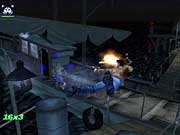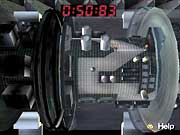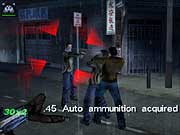Nothing delivers a vicarious thrill quite like a slick, big-budget action movie. Hollywood blockbusters like Face/Off and The Rock, or some of Hong Kong's finest like The Killer and A Better Tomorrow, put you right in the middle of intense modern-day shoot-outs between the goodest good guys and the baddest bad guys. Films like these are undeniably exciting, but they sometimes leave you wondering how on earth the good guys managed to beat those impossible odds. The answer is obvious--the movie isn't real. Of course, Namco's new Xbox shooter Dead to Rights isn't real, either. But if you've ever wondered what it might feel like to be the lone action hero up against a ridiculous number of enemies, this game is probably the closest you'll get anytime soon. In development for years, Dead to Rights nevertheless has some unfortunate problems--it looks dated, the camera is frequently obtrusive, and the controls take a lot of getting used to. The game is also often frustratingly difficult. But no one said being the hero was going to be easy. Overlooking its problems and getting past that learning curve certainly won't be, but if you manage to, you'll find that Dead to Rights is an intense and challenging game.

Dead to Rights is about a K-9 cop named Jack Slate, who does what he can to keep the peace in a criminal cesspool called Grant City. Early on, Slate and his trusty dog Shadow must investigate a mysterious construction site. There, Slate discovers that someone very close to him has been murdered. Against direct orders, he sets off to find some answers and get revenge. The game's story, told through Jack's deadpan narration and the occasional CG cutscene, seems pretty straightforward at first. But during the course of the game, it actually takes some decent twists and eventually becomes quite involving. The best that can be said for it is that, unlike most stories in games, this one does a commendable job of tying up all its loose ends before the credits roll. Actually, for a shooter, Dead to Rights is surprisingly long, consisting of well over a dozen big, action-packed chapters.
Superficially, Dead to Rights unquestionably resembles last year's popular shooter Max Payne--mostly because that game, like Dead to Rights, is clearly inspired by a certain breed of action movies, the most notable of which is probably The Matrix. Like Max Payne, Dead to Rights is the story of a fugitive cop who's apparently fighting alone in his war against a sinister, corrupt organization. Even the game's respective main characters have a lot in common. Their names sound alike, their dialogue is hammy and melodramatic, they shrug off bullet wounds, they shoot rapidly with two pistols at once, and when they leap through the air, all the action around them slows down. That's a lot of similarities, but that's also where the similarities end.
Dead to Rights plays differently from Max Payne--and from most other action games, for that matter. Most of the game consists of third-person action sequences in which Slate will have to gun down countless foes before reaching his next objective. But just as the plot in Dead to Rights offers up a few surprises, so does the gameplay. Simple yet inventive minigames frequently figure into the action, as Slate will have to do all kinds of things, from disarming bombs to lifting weights to picking locks. These minigames rely on precise timing or button mashing, and they make for fun diversions, though like the rest of the game, they can be difficult. And they're never optional--it's do or die. Also, Slate will have to fight unarmed in a number of sequences, and he can switch to unarmed combat in the middle of a gunfight, too.
There's a lot to say about the action in Dead to Rights because Slate is a versatile fighter. He can carry a number of different firearms at once, and the game features a wide selection of real-world pistols, shotguns, submachine guns, assault rifles, sniper rifles, and more. He'll typically salvage these from fallen foes, but he wastes no time reloading, opting instead to coolly toss aside depleted weapons. Aiming in Dead to Rights is automatic--just press and hold the right shoulder button and Slate will draw a bead on the closest foe. Once that enemy goes down, press the right shoulder button again to find your next target. You can also opt to manually aim from a first-person perspective, and you'll sometimes need to do so when using sniper rifles. Unfortunately, manual aiming is cumbersome in Dead to Rights, and most times when you're trying to target an enemy sniper's noggin, he'll already be firing on you.

Your enemies are plentiful, reasonably smart, heavily armed and armored, accurate, and deadly. If you wish to improve your chances of survival, you'll need to make use of all of Slate's defensive maneuvers while fighting. A martial arts expert, Slate can disarm his foes at close range, snatching their weapons while delivering a deathblow with dramatic flair. Alternatively, he can put a vice grip on most any foe, using the opponent as a human shield while retaining the ability to shoot back (at least with one weapon). If his hostage isn't killed by friendly fire, Slate can coldly put the fool out of his misery with a bullet to the head or a shot in the back. This isn't exactly lighthearted stuff. You'll probably like that.
Slate's got even more moves. He can duck behind cover and also flatten his back against a wall, priming himself to spring out and start shooting from around a corner. And, sure enough, he can leap through the air in any direction while keeping his guns trained on his foes. Pressing and holding the Y button causes the action to go into slow motion in mid jump, allowing you to take out several targets before you hit the ground. This maneuver is hardly realistic, but it's exciting and a real lifesaver. Your ability to use it is governed by an adrenaline meter that works like bullet time in Max Payne. The meter fills back up as you defeat enemies, and it also refills gradually with time, but it's well balanced so you can't get away with using this powerful move excessively.
Guess what? Slate's got even more tricks up his sleeve. He can grab explosive canisters conveniently strewn about some of the levels, toss them at his foes, and then shoot the canisters as they're nearing their targets, allowing you to blow up several baddies at once. Unarmed, Slate can perform various combinations of punches and kicks, as well as a limited number of grappling moves. He can block enemy punches and kicks, too, or break enemy grapples with a well-timed button press. And don't forget Shadow, the dog, who basically works like a recharging super weapon. You "equip" Shadow like any other weapon, target a foe and push the fire button as you normally would, and then you'll suddenly be watching a slow-motion close-up of Shadow mauling the victim. The faithful mutt then kindly brings the enemy's weapon to you and vanishes as suddenly as he appeared. He'll be ready for another meal in less than a minute. You'll rely on Shadow often, but as a gameplay mechanic, this dog could have used some more attention. The way he's implemented just doesn't make any sense--you get the impression that the developers couldn't really get Shadow to work quite like they wanted him to, so they cut corners. At any rate, don't worry about sending your dog into the middle of a firefight, because he'll always come out unscathed. If only you were so lucky.

Considering that Dead to Rights spent a while in development, it's surprising to see problems like disappearing dogs. Other aspects of the game clearly could have used more work, too--especially the camera. Usually, you can rotate the camera around using the right analog stick. You'll have to, because the camera doesn't do a good job of tracking your movement all by itself. As you might imagine, having to futz with the perspective while trying to take on a dozen enemies with AK-47s doesn't make the proceedings any easier. The camera also wigs out whenever you get into tight corridors, and you'll be in tight corridors fairly often. Additionally, the camera angle is unpredictably locked in some sequences, but this isn't any better than the free-roaming camera and will only disorient you even more. The only thing good about the camera is how it snaps to whichever enemy you have targeted. Beyond that, it's arguably the most dangerous enemy you'll face throughout the game. During brawling sequences, you'll frequently get blindsided by enemies who attack you from just off the edge of the screen. These situations could have been avoided if the camera worked more intelligently and interacted better with surrounding objects, or if the game at least used visual indicators to point out enemies that Slate can see but you can't.
The camera makes Dead to Rights particularly frustrating at times, but it's a very difficult game regardless. You'll be constantly on the lookout for health and armor power-ups, which can instantly take you from death's door to perfect shape--not that Slate looks or acts differently depending on his health and armor levels. The shooting sequences are actually fun once you get the hang of them, though they're relentlessly tough. Throughout the game, you'll also take on a number of powerful bosses, and while the early boss battles are straightforward slugfests, some of the later ones are much more interesting. The brawling sequences usually are neither interesting nor particularly fun, though. Your enemies will block and counterattack seemingly at random, and all your foes dish out big damage. Disappointingly, all your standard foes also use the same canned punch-and-kick combos and throws that you have access to. Worse yet, though you'll be fighting large groups of enemies hand-to-hand, you can't knock or throw an enemy into his cohorts. Enemies won't coordinate their attacks, either, and they'll stand idly by as you beat up their pals. Then again, you won't be wishing for the brawling sequences to be any harder. Success in these battles requires either a lot of luck or some cheap keep-away tactics to throw off the enemy AI.
Death in Dead to Rights comes swiftly and often. You can save your progress at any time, but loading a saved game will start you off at the last checkpoint rather than where you last saved. Some checkpoints can be pretty far apart, so you'll often play through some lengthy sequences over and over again. It's a small blessing that loading times are virtually nonexistent in the game.
That's about the best that can be said for the game's technical merits. Jack himself looks OK, and you'll see him sporting several different outfits throughout the game, but many of the other characters look blocky and simple. Most of the game's environments can be described in the same fashion, as they all use lots of bland, blurry textures. For what it's worth, though, some of the levels--like the neon-lit streets of Chinatown--do look considerably better than others do. Interestingly, none of the game's environments are destructible, so you'll use things like wooden boxes to protect yourself from munitions that would rip right through them in real life. Dead to Rights does feature some stylish animations, especially for Jack Slate's various combat moves, and some of the special effects are well done, though the garish pools of blood left behind by slain enemies look like something out of a horror movie.

The game also sounds pretty good. The voice acting is hit-and-miss, though Jack has some pretty good lines. The music is mostly subdued and at times repetitive, but the report of all the various weapons is loud and realistic.
Despite its appealing premise, the gameplay of Dead to Rights won't appeal to everyone. The game gets very hard in a hurry, and then it mostly just keeps getting harder from there. It's the sort of game that many are likely to stop playing in frustration and never come back to. But, armed with the knowledge that the game does get better as it wears on, you may find yourself enjoying Dead to Rights as you force your way through its numerous, seemingly impossible scenarios. The game could have certainly been better in a number of ways, but if you're the sort who's been able to finish most recent games without breaking a sweat, then you'll likely respect the challenge that this one has to offer.